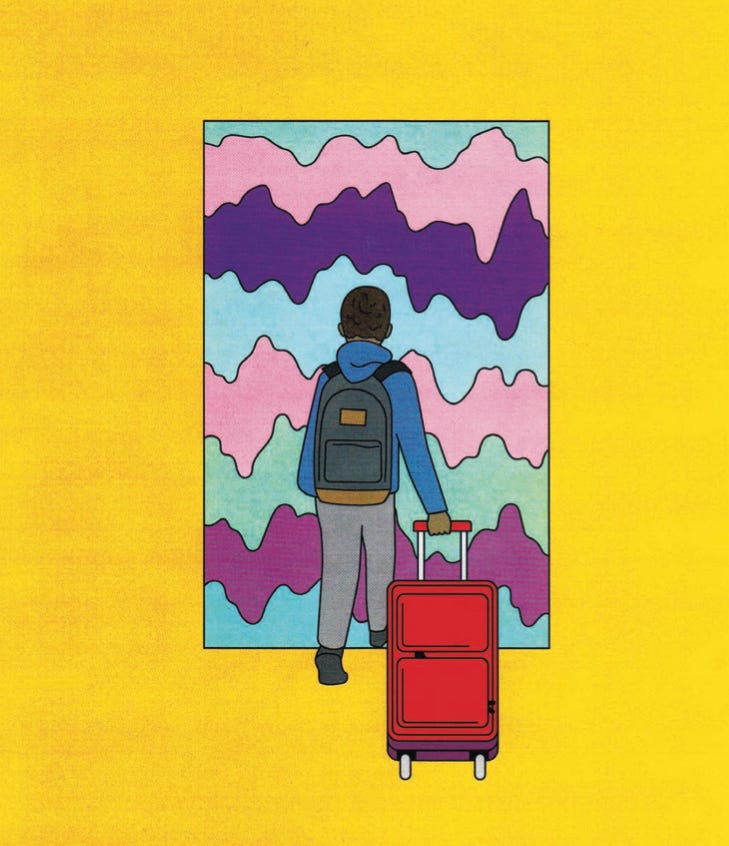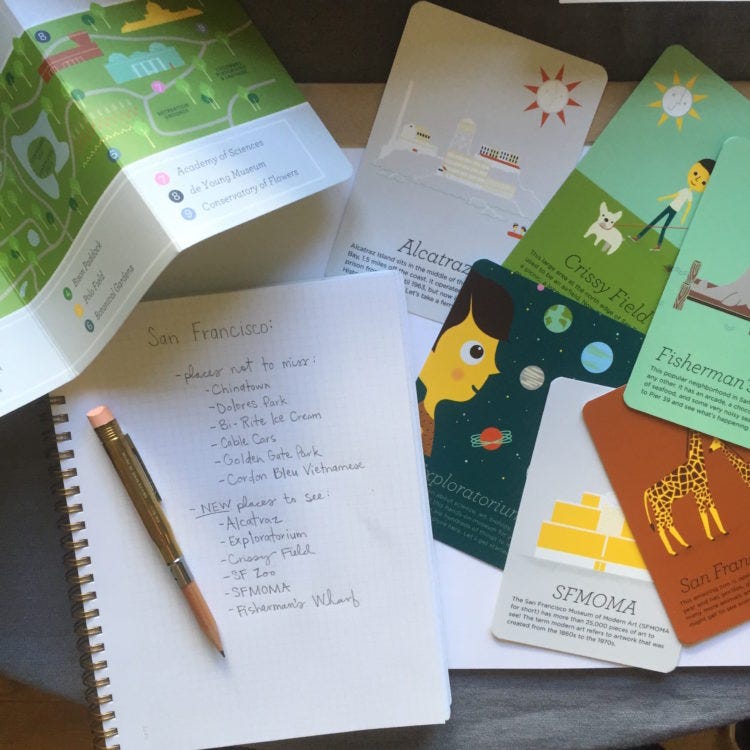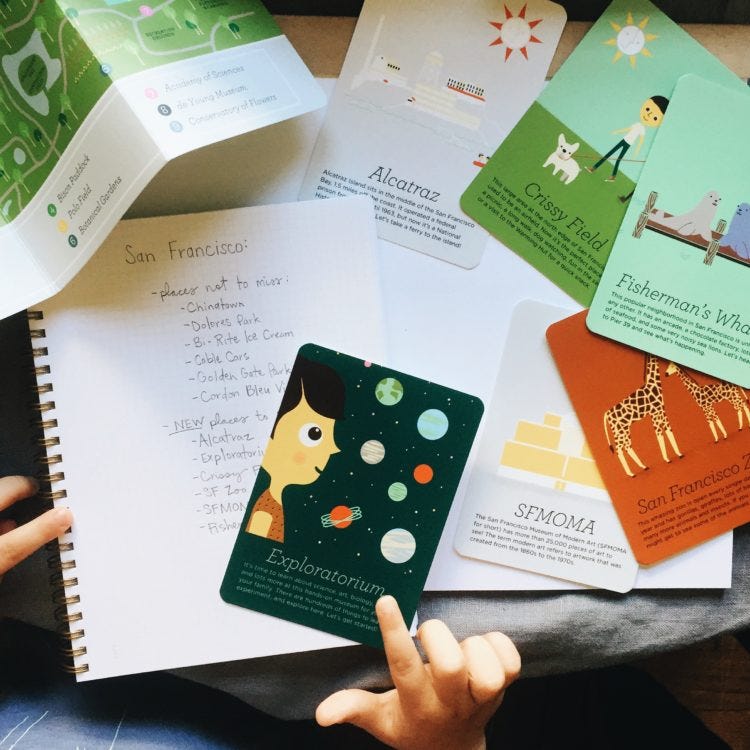Hello!! Funny story… last week was supposed to for all of my readers and it only got sent to my paid readers. Let’s call it an April’s Fools Day joke. So this week, this post is for everyone that reads here. If you aren’t currently subscribed to the Field Trip newsletter, you can do so below.
We are finally starting to plan a trip. I can honestly say I didn’t think it would be this long, but also I didn’t think we’d get here again. But here we are! YAY! I’m such a planner. I like to have everything sorted weeks in advance. As a child, I would pack my own suitcase three days early. My mom still loves to remind me of that. At five years old, I would ask her how many days we’d be gone so that I could pack the correct amount of underwear for the trip. My grandfather would call me two days before a trip, just to see if I had packed the day before. I always had.
Preparing for a family trip is one of the things I love most about traveling. I love thinking of all the possibilities, researching activities, and figuring out what gear we’ll need. But I’ve spoken with a lot of parents who are overwhelmed by travel because of the planning: deciding what to pack, planning kid-friendly activities, dealing with the cost of travel, and so on. I understand why traveling with kids can feel daunting, but I think what you gain from traveling with your children makes it all worth it. And if you’re strategic, you can make the planning as fun as the trip itself! Below, I’ll provide tips, resources, and activities that will hopefully alleviate some of the stress associated with traveling with kids so that you and your family can make wonderful travel memories.

When our son was very young, I got him in on the planning stages of our travels. I have always asked Tom what sorts of things he wants to make sure to do and see. And eat! Living in a small town, our choices are limited, so eating food we can't normally get, on trips is such a major part of travel for us.
I’m a big believer that when we include children in the process, they are likely to enjoy the travel more. We seek out cool playgrounds, local children's activities, museums that are child-friendly, and so on. Whether you’re planning an extended vacation abroad or a long weekend not too far from home, it’s important to go at your own pace. There are many different types of travel styles, from slow travel where you take your time and wander with no concrete agenda, to action-packed adventures where you plan to do as much as possible in a short amount of time. It can be easy to get caught up by how other families plan their trips, but make sure you’re creating a trip that feels comfortable for you and your family.
Avoid high season if possible: Your family will enjoy your trip so much more if you’re not surrounded by tons of other tourists. Prices for hotels and flights often soar during peak season, so booking during the off-season can save you money. I realize it can be difficult to plan around your child’s school schedule, so find out whether your child’s school allows for travel during school days. Although my son is in a traditional school, I am allowed to take him out to travel with permission from the principal. Because travel can be so educational, his school is willing to work with parents to allow kids to miss classes and make up for the missed schoolwork.
Make a map: Once you have settled on your destination, start to make lists of places you’d like to try to work in. I tend to find more places than I could ever visit in one trip, but it just means that next time I return, I already have a list figured out of new places to see. Once you have your list, use an app like Google Maps to pin each location on your list. Before I started mapping out our travel activities, I’d realize later on that I’d been right around the corner from a shop I wanted to visit or a park I wanted to make sure to take Tom to but didn’t realize it because I didn’t have the map sorted out. Mapping out your plans ahead of time will help you organize activities more strategically and allow you to see things you don’t want to miss.
Don’t try to pack it all in: Don’t feel pressured to see and do every single thing on your list. Pick a few places to see and give yourself time to really enjoy the experience. Remember that children can be easily exhausted or overwhelmed during travel, so taking a slower approach will ensure that everyone is happy and comfortable.
Make Time for Rest: Travel can be exhausting for children. Building downtime and naps into your travel schedule is an important part of making sure everyone has a good time. When my son was younger, I planned our daily adventures around his naps. I wanted to make sure that he was well-rested, which helped us avoid meltdowns and made our days far more pleasant. Make sure you allow for time to decompress between activities.
PACKING OUR BAGS TO HIT THE ROAD

Packing for a trip can be daunting and overwhelming, but I’m here to tell you, it doesn’t have to be. Here are some tips I’ve found to be helpful when we’re packing for a family trip:
Start packing several days before your trip: This gives you time to think and rethink what you are taking and adjust your bag accordingly. Instead of throwing everything together the night before your trip, packing ahead of time provides a few days to edit your bag and takes some of the stress out of last-minute packing. You won’t have to look for items that have gone missing or run to the store for an item at the last minute. This all helps to stress levels to a minimum.
If traveling by airplane, plan to check most of your bags: I recommend that each person bring a small carry-on and check everything else. I do this with my own family because in my experience it’s just too difficult to navigate busy airports and crowded airplanes with all our luggage. What’s the $25 bag fee at the end of the day? Or better yet, pay for flights with an airline credit card, and bag fees are usually waived.
Wear what you know: Don’t be tempted to buy a bunch of new clothes for a trip. Instead, I recommend packing tried-and-true items that you and your children wear on a regular basis. That way you know everyone will be comfortable on your travels, rather than regretting a new purchase that doesn’t fit right or having to break in a new pair of shoes.
Bring multiuse items that can be layered: Pack items that can be worn to
a variety of places. For example, I pick things like dark jeans, a dark-colored button-up top with a T-shirt underneath, and a cardigan that I can wear from the museum to the park to a restaurant for dinner. I also recommend packing items that you can layer so that you don’t have to pack bulky jackets, which take up a lot of room and you may not end up needing (though of course if you’re traveling to a cold place, bring warm coats!).Think about packing in a color palette, like all gray, black, and white, so that it’s easy to mix and match your pieces without clashing or the need to over-pack.
Stick with darker-colored clothing: Darker clothes make it easy to hide little stains that you might not be able to tend to right away when traveling.
Color code: Organize your belongings into small, color-coded packing cubes and assign a color to each member of your family. These simple cubes make for easier packing and unpacking so you don’t have to rifle through everyone’s belongings every time you’re trying to find something.
Consider whether you’ll have access to laundry: You can pack a lot less if you know you’ll have access to laundry. You can do laundry almost anywhere, whether it’s at a local Laundromat, at your rental home, or through your hotel’s laundry service or drop-off service.
Don’t bring the kitchen sink: Packing for children can feel like you are packing enough belongings to clothe and entertain a small town. Consider whether you can pick up some of the things you need at your final destination, and remember that you can usually buy essential supplies like diapers, shampoo, snacks, and even toys in most locations.
Ask your child to participate in the packing process: This will help them envision the upcoming trip and give them a chance to ask questions about the place you’re visiting. And if they get to help decide what to pack, it’s more likely that they’ll be happy with the outfits, toys, and supplies you bring. This will also help them become better planners and packers so that they can eventually pack for themselves, without your help.
IDEAS TO ENCOURAGE WONDER WHEN TRAVELING:
VISITING A CITY: Traveling in a city doesn’t have to be overwhelming. Do some research ahead of time to figure out a plan for how you’ll get around and whether you need to book certain activities—like shows, museum passes, or landmark visits—ahead of time. If you’re renting a home, ask your host for local recommendations that are child-friendly; if you’re staying at a hotel, speak with someone at the front desk. Here are some tips for making the most of your city visit:
Count how many public works you can find.
Look for street musicians and enjoy a mini-concert.
Hop on a city bus and let it take you on a sightseeing journey.
Find a classic movie theater and see a movie.
Visit a farmer’s market and talk with the farmers.
Visit a local museum or art gallery and talk with the curator about the selected works.
VISITING A SMALL TOWN: I love the slow pace that comes from visiting small towns. Small towns provide opportunities to shop in local, family-owned stores, eat in small restaurants that serve regional cuisine, and connect with residents in meaningful ways. You visit a small town for the slower pace of travel, so embrace it! Here are a few ideas to get you started on your next family trip to a small town:
Stop by the local tourism bureau for maps and travel insight.
Wander down the main street and chat with local shopkeepers.
Rent bikes to get around town.
Visit a local artist’s studio.
Head to the local library or bookstore for storytime.
VISITING RURAL AREAS AND MOUNTAIN TOWNS: I love visiting rural areas—taking winding roads, peering through the trees to spot the occasional house or small town. When we’re traveling to a rural place, we try to make time to stop at scenic overlooks, plan a picnic with a view, and take a child-friendly hike. These trips provide wonderful opportunities for slowing down and enjoying the great outdoors. Here are a few activities to consider for your next rural adventure:
Find a creek and race dead leaves downstream.
Go bird-watching.
Rent a canoe or kayak and paddle down a river.
Build a fire and roast marshmallows.
Rent fishing poles and spend an afternoon fishing.
Go on a nature walk. Pick wild blueberries.
Take a gondola or chairlift to the top of a ski mountain.
VISITING A BEACH TOWN: The beach is a natural wonderland for learning. You can look for shells, build a sandcastle, gather clams, write notes in the sand, go for long beach walks, plan a treasure hunt, walk out to a sandbar, look for tide pools, and watch for dolphins or whales. If you’re looking for some time away from the sand and water, here are a few ideas for beach town activities:
Visit the local port and watch boats coming and going.
Rent bikes and pedal around town.
Visit the maritime museum.
Visit local art galleries.
Walk the boardwalk.
Eat at seafood restaurants serving the catch of the day.
Attend a local film or food festival.
Tackling Time Zones and Scheduling When Away from Home:
Changing time zones can be really difficult for children. I’ve heard so many parents talk about their child waking up at 3 a.m. on a trip and not going back to sleep for hours. The best trick I learned from my travel nanny years, after many trips around the world with children, is to acclimate children to the local time as quickly as possible. Coordinate flights and time zones as best you can to avoid disturbing their regular sleeping routine. For example, my son goes to bed at 7:30 PM Mississippi time, and say we were going to France, which is six hours ahead of us. I would look for flights that left in the afternoon and arrived in France the next morning. I’d encourage him to sleep on the airplane, dressing him in comfortable clothes that he can sleep in, read him a bedtime story, and have him brush his teeth on the plane so that it feels like our normal bedtime routine. Once we arrived, I would keep my son up until his normal bedtime of 6:30 PM Paris time. This would help quickly acclimate him to the local time.
If your child has a hard time sleeping on planes or in unfamiliar places, then plan a flight to get into your location a few hours before their bedtime at the new local time, so that you have time to get to your hotel and settle in for the night. For long flights, plan on the travel day also being a take-out sort of night. Use those planning skills to find a place nearby to your hotel and order on your way to check-in.
I think you have this! I feel confident that you can go back into the world, a bit more prepared and ready to plan your next trip. Obviously, with the way COVID-19 is, plans might be a bit skewed or look a little different, but you will be ready for the “one day” or at least be a bit less frazzled with acclimating to small changes moving forward. I’m just a DM away! Send me a message if you aren’t feeling so confident in the process. I’m happy to answer your questions and help walk you through it. - Erin
PS… If you don’t have my book, you can find it here, here, here, and here, depending on what business you prefer to support. Also, some of my favorite travel gear can be found here. I’m always updating it too, so check in often and see what cool things I’ve found.
PPS… As always, please share this newsletter with a couple of friends or family! I’d love to see this space grow and grow. Tell your new parent friends, nannies in your lives, grandparents, your friend from middle school that has kids, and so on… Most of all, THANK YOU FOR BEING HERE! So glad that you are.
PPPS… This playlist has been my jam lately. It’s 21 hours long, but has something for everyone and is sure to get you through a day of travel planning, long flights, and so on… Can I even call it a playlist at this point? I don’t know what you would call it, other than awesome. My attempt at cheesy humor… I digress. On that note, have a great day!






